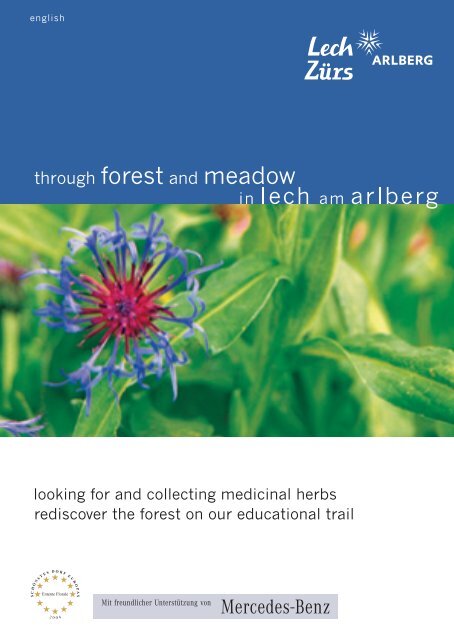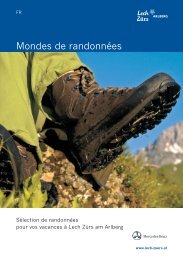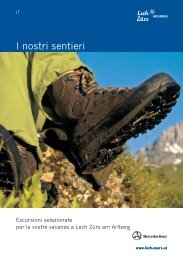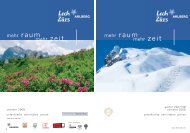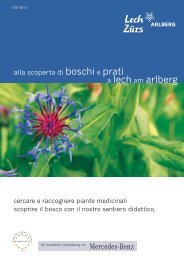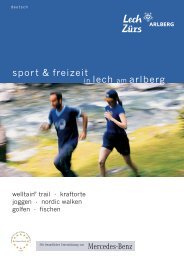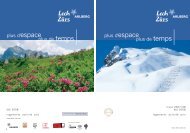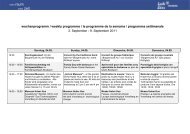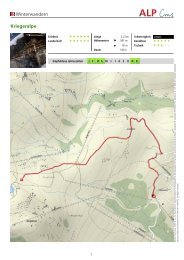Lech-Zürs - through forest and meadow
looking for and collecting medicinal herbs rediscover the forest on our educational trail
looking for and collecting medicinal herbs rediscover the forest on our educational trail
You also want an ePaper? Increase the reach of your titles
YUMPU automatically turns print PDFs into web optimized ePapers that Google loves.
english<br />
<strong>through</strong> <strong>forest</strong> <strong>and</strong> <strong>meadow</strong><br />
looking for <strong>and</strong> collecting medicinal herbs<br />
rediscover the <strong>forest</strong> on our educational trail
Information:<br />
<strong>Lech</strong> <strong>Zürs</strong> Tourismus GmbH<br />
A-6764 <strong>Lech</strong> am Arlberg<br />
Tel. 0043/5583/2161-0, Fax 0043/5583/3155<br />
Email: info@lech-zuers.at, www.lech-zuers.at<br />
Georg Schnell, Tel. 0043/5583/2617<br />
Imprint:<br />
Publisher: <strong>Lech</strong> <strong>Zürs</strong> Tourismus GmbH<br />
Photography: Georg Schnell <strong>and</strong> Rupert Pöttinger<br />
Text: Rupert Pöttinger – 6714 Nüziders<br />
Georg Schnell – 6764 <strong>Lech</strong><br />
Arnica <strong>meadow</strong> against<br />
the “Mohnenfluh”<br />
Mountain ash at<br />
the “Spullersee”
our medicinal plants are a gift of nature!<br />
More <strong>and</strong> more people are using their healing powers to do something<br />
for their health – <strong>and</strong> rightly so, because medicinal plants<br />
work naturally <strong>and</strong> have almost no side-effects. Nowadays, medicinal<br />
plants are used successfully in everyday medicine – as teas, tinctures<br />
<strong>and</strong> special medications made from single active ingredients.<br />
They can support the healing process of various illnesses, alleviate<br />
complaints <strong>and</strong> work with a preventive effect.<br />
However, the use of this little herb compendium only makes sense<br />
if you are completely familiar with the plants <strong>and</strong> are also aware of<br />
the possibilities <strong>and</strong> limits of using them.
collecting<br />
● Anyone who collects their own medicinal herbs takes on a serious<br />
responsibility, as a lack of knowledge can result in confusion - possibly<br />
even with poisonous plants! (In case of doubt, please obtain<br />
herbs from a pharmacy).<br />
● The best time to go collecting is in the morning when the sun is shining,<br />
never when it is raining or damp.<br />
● Do not pick any dirty plants or those growing at the roadside, as<br />
medicinal herbs must never be washed!<br />
● Protect nature:<br />
– Avoid depletion by taking only as many plants as you need, <strong>and</strong> no<br />
more than required for one year.<br />
– Use scissors when collecting, to avoid ripping out the roots.<br />
– Do not collect any protected plants! (Visit a pharmacy instead)<br />
– Tread carefully <strong>through</strong> <strong>meadow</strong>s, <strong>and</strong> do not trample them to pieces.<br />
Collecting in open nature already has a „medicinal effect“, but please<br />
remember that all herbs are available in top quality from your pharmacy.<br />
drying<br />
● Immediately after the harvest.<br />
● Quickly <strong>and</strong> protectively.<br />
● In a shady, well-ventilated place, ideally on a sifting screen or hung<br />
in bundles.
storage<br />
● Ideally in a well-sealed <strong>and</strong> tinted glass jar.<br />
● Remember to add a label <strong>and</strong> the date of collection.<br />
● Do not store for longer than one year, as older plants lose their efficacy.<br />
preparation<br />
● Rule for making tea: pour 1/4 litres of boiling water over 1 – 2 tea -<br />
spoons of herbs; allow to infuse for 10 minutes.<br />
● Prepare mixtures in equal parts.<br />
● Roots: bring 1 teaspoon with 1/4 litre of water to the boil <strong>and</strong> allow<br />
to infuse for 10 minutes.<br />
… <strong>and</strong> remember<br />
● Also use medicinal herbs when you are feeling well: prevention is the<br />
best cure.<br />
● No one herb is grown to cure everything: Despite all the positive<br />
experiences had with our medicinal herbs, you should always consult<br />
a doctor immediately if you fall ill!
1<br />
2<br />
3<br />
4<br />
field horsetail<br />
equisetum arvense<br />
Use: Tea (made from the whole herb), 2 – 3 cups per<br />
day. Effect: Helps with kidney <strong>and</strong> bladder infections,<br />
rheumatism, gout, arthritis, blood cleansing,<br />
connective tissue (hair, finger nails, cellulitis)<br />
arnica arnika montana<br />
Use: Apply externally only (poisonous!).<br />
Effect: For strains, grazes, contusions <strong>and</strong> bruises!<br />
Arnica wraps also for greasy, poorly healing<br />
wounds. Good for inflammation in the mouth <strong>and</strong><br />
throat.<br />
eyebright euphrasia officinalis<br />
Use: Wraps <strong>and</strong> eye washes, tea (made from the<br />
whole herb), 2 cups per day.<br />
Effect: The tea works <strong>through</strong> wraps on various eye<br />
inflammations, especially conjunctivitis, blepharitis<br />
<strong>and</strong> tear-flow. The tea strengthens the powers of<br />
resistance (especially in children).<br />
mugwort (common) artemisia vulgaris<br />
Use: Tea (made from the whole herb), 1 – 2 cups<br />
per day. Effect: For promoting the production of<br />
stomach <strong>and</strong> intestinal juices. Highly recommended<br />
for bilious complaints. Excellent herb for fatty<br />
dishes (roast duck <strong>and</strong> goose)
5<br />
6<br />
7<br />
8<br />
greater burnet saxifrage pimpinella major<br />
Use: Tea (from the root), chopped root is boiled<br />
briefly <strong>and</strong> strained. Effect: For inflammations of<br />
the upper respiratory tract: hoarseness, sore throats<br />
(gargling <strong>and</strong> swallowing). The tincture is used<br />
for bronchitis <strong>and</strong> asthma (30 drops in a glass of<br />
water). Note: Danger of Confusion!<br />
silver birch betula pendula<br />
Use: Tea (leaves), 2 – 3 cups per day.<br />
Effect: Strongly diuretic. Helps with kidney <strong>and</strong><br />
bladder complaints.<br />
blood root potentilla erecta<br />
Use: Tea (made from the root), 2 – 3 cups per day<br />
or tincture. Effect: Gargling agent for inflamed tonsils<br />
<strong>and</strong> gum inflammations. Works excellently on<br />
heavy diarrhoea. Note: In some Alpine areas an<br />
aromatic <strong>and</strong> digestion-promoting blood root<br />
schnapps is produced (<strong>Lech</strong>!).<br />
selfheal (common) prunella vulgaris<br />
selfheal (gr<strong>and</strong>iflora alpine)<br />
prunella gr<strong>and</strong>iflora<br />
Use: Tea (made from the whole plant), 2 – 3 cups<br />
per day – rinses. Effect: Helpful for diabetes, liver<br />
<strong>and</strong> gall bladder complaints (Chinese medicine).<br />
Gargle with the tea for tonsil inflammations.
9<br />
10<br />
11<br />
12<br />
stinging nettle urtica dioica Use: Tea (made<br />
from the whole herb), 2 – 3 cups per day. Effect: For<br />
promoting the body’s overall metabolism, diuretic,<br />
therefore highly recommended for rheumatism <strong>and</strong><br />
gout. Promotes formation of blood cells, therefore<br />
beneficial for anaemia. Liver <strong>and</strong> gall bladder complaints.<br />
Favourable influence on diabetes.<br />
watercress nasturtium officinale<br />
Use: Raw leaves as salad.<br />
Effect: Contains vitamins A, C <strong>and</strong> D, as well as<br />
potassium <strong>and</strong> iron.<br />
Cleans the blood <strong>and</strong> lowers fevers. Highly recommended<br />
for diabetes.<br />
common speedwell veronica officinalis<br />
Use: Tea (made from the whole herb), 2 – 3 cups<br />
per day.<br />
Effect: For chronic skin complaints, eczema <strong>and</strong><br />
abscesses, also for bronchial catarrh, lowers cholesterol.<br />
gentian (yellow) gentiana lutea Use: Tea (made<br />
from the root), or as a tincture. Effect: Promotes the secretion<br />
of stomach juices, thereby helping with poor digestion<br />
due to a lack of acid. (Not suitable for a nervous stomach<br />
with excess acid). Effective on exhaustive conditions<br />
(schnapps on sugar lump).In the Alpine regions, the excellent<br />
Gentian Schnapps is distilled from the gentian root.
13<br />
14<br />
15<br />
16<br />
cornflower (mountain) centaurea montana<br />
Use: Baths.<br />
Effect: The flower in the bath works well on the skin<br />
<strong>and</strong> promotes elimination.<br />
lady’s mantle alchemilla vulgaris<br />
Use: Tea (made from the whole herb), 2 – 3 cups<br />
per day <strong>and</strong> rinses. Effect: Women’s tea – especially<br />
for complaints during the menopause – for heavy<br />
periods. For stomach <strong>and</strong> intestinal complaints<br />
with diarrhoea. Externally, also for gargling in the<br />
mouth <strong>and</strong> around the throat.<br />
lady’s mantle (alpine) alchemilla alpina<br />
silver mantle (alpine form of lady’s mantle)<br />
Use <strong>and</strong> Effect: As for no. 14 Lady’s Mantle<br />
Also good for obesity.<br />
silverweed potentilla anserina<br />
Use: Tea (made from the whole herb), 1 – 2 cups<br />
per day.<br />
Effect: Relieves cramp during heavy periods.<br />
Also for rheumatism, gout <strong>and</strong> diabetes.
17<br />
18<br />
19<br />
20<br />
golden rod solidago virgaurea<br />
Use: Tea (made from the whole herb), 2 – 3 cups<br />
per day. Effect: Especially for the treatment of<br />
bladder <strong>and</strong> kidney inflammations, for painful urination,<br />
as well as for passing of water.<br />
good king henry chenopodium bonus-henricus<br />
Use: Wild vegetable – wraps<br />
Effect: Very good wild vegetable (use like spinach)<br />
Effective for anaemia, calms inflamed skin <strong>and</strong><br />
mucous membranes (wraps for abscesses).<br />
whortleberry vaccinium myrtillus<br />
Use: One small glass of tea (made from the dried<br />
berries), several times a day. For small children 3 –<br />
5 tablespoons to alleviate diarrhoea.<br />
Effect: Helps internally with diarrhoea <strong>and</strong> as a gargle<br />
for mouth, gum <strong>and</strong> tonsil inflammation.<br />
shepherd’s purse capsella bursa-pastoris<br />
Use: Tea 2 – 3 cups per day<br />
Effect: Especially as a haemostyptic during heavy<br />
periods.
21<br />
22<br />
23<br />
24<br />
black lace sambucus nigra<br />
Use: Tea (made from the flowers), 3 – 4 cups per<br />
day. Effect: Sweating tea for feverish colds <strong>and</strong> flu.<br />
Mobilises the body’s own powers of defence. For<br />
the prevention of flu <strong>and</strong> colds.<br />
coltsfoot tussilago farfara<br />
Use: Tee (made idealy from the young leaves or<br />
from the flower).<br />
Effect: Excellent against coughs <strong>and</strong> bronchitis.<br />
For chronic bronchitis, the tea facilitates the coughing<br />
up of bronchial mucous.<br />
icel<strong>and</strong> moss cetraria isl<strong>and</strong>ica<br />
Use: Tea 2 – 3 cups per day.<br />
Effect: Helps colds with coughs, bronchitis<br />
As a gargle for sore throats.<br />
st. john’s wort (common) hypericum perforatum<br />
Use: Tea 3 cups per day over 7 – 8 weeks. Oil made<br />
from the flower <strong>and</strong> leaves. Effect: Has a calming<br />
effect. Anxiety, insomnia, depressive conditions, bed<br />
wetting – recently also as a prevention for heart<br />
attacks. St. John’s Wort is also very good for swollen<br />
gl<strong>and</strong>s, back pains, sciatica <strong>and</strong> as a skin care agent.
25<br />
26<br />
caraway carum carvi<br />
Use: Tea (made from the seeds), 2 cups per day.<br />
Effect: Helps with digestive problems.<br />
Note: Careful! Only collect the plants if you a certain<br />
you can identify them. There are few extremely<br />
poisonous types amongst the umbellates to<br />
which the plant belongs.<br />
27<br />
28<br />
woolly mullein verbascum thapsiforne<br />
Use: Tea (made from the flowers (pharmacy or herb<br />
stockist)), 2 – 3 cups per day. Effect: Excellent for dry,<br />
hacking cough. The effect increases if Ribwort Plantain<br />
<strong>and</strong> Coltsfoot leaves are added in equal measure. This<br />
mixture has also proven very effective for bronchitis.<br />
white bedstraw galium mollugo<br />
yellow bedstraw galium verum<br />
Use: Tea (made from the whole herb), 2 – 3 cups<br />
per day – pressed juice. Effect: Both types of Bedstraw<br />
are excellent against all types of kidney complaint.<br />
The freshly pressed juice is often used to<br />
fight skin conditions such as scaliness <strong>and</strong> eczema.<br />
Now also used for bathing psoriasis.<br />
d<strong>and</strong>elion taraxacum-officinale<br />
Use: Tea (made from the root), 3 cups per day.<br />
Effect: Stimulates the kidneys <strong>and</strong> liver to increase<br />
activity <strong>and</strong> improves the general feeling of weak -<br />
ness in people. No further formation of gall stones<br />
(4-week treatment).
29<br />
30<br />
31<br />
32<br />
masterwort imperatoria ostruthium<br />
Use: Tea (made from the root).<br />
Effect: Masterwort is highly prized, especially in<br />
the Alpine countries. Especially for stomach,<br />
intestine, gall bladder <strong>and</strong> liver problems. Strengthens<br />
the powers of resistance (1 teaspoon of powdered<br />
root in a glass of red wine).<br />
Note: Danger of Confusion<br />
motherwort ligisticum mutellina<br />
Use: Tea (made from the whole herb), 2 – 3 cups<br />
per day. Effect: Strengthens women’s abdomens,<br />
increases milk secretion. Note: Danger of Confusion<br />
lingonberry vaccinium vitis-idaea<br />
Use: Marmalade or mousse (1 – 2 teaspoons before<br />
meals).<br />
Effect: Helps with lack of appetite, especially in<br />
children. Popular in the kitchen (e.g. as a dressing<br />
for Wiener Schnitzel).<br />
pot marigold calendula officinalis<br />
Use: Tea (made from the flowers), 2 – 3 cups per<br />
day, ointment.<br />
Effect: Blood cleansing, stomach cramps, large<br />
intestine inflammation <strong>and</strong> liver complaints.<br />
The Pot Marigold works excellently on poorly healing<br />
wounds, lower leg ulcers, nail bed inflammation,<br />
sprains <strong>and</strong> dislocations.
33<br />
34<br />
yarrow achillea millefolium<br />
Use: Tea (made from the whole herb; upper part), 2<br />
– 3 cups per day. Effect: Promotes digestion,<br />
dispels bloatedness, heartburn. Helps with gastritis<br />
<strong>and</strong> intestinal inflammations. Also for liver diseases.<br />
Very good for women – especially for menopausal<br />
complaints.<br />
35<br />
36<br />
herb robert geranium geranium robertianum<br />
Use: Tea (made from the whole herb), as a gargle<br />
<strong>and</strong> for ablutions.<br />
Effect: Ablutions (tea) for scaly skin <strong>and</strong> eczema.<br />
As a gargle for gum inflammation.<br />
cowslip primula veris<br />
Use: Tea (made from roots <strong>and</strong> flowers), 2 – 3 cups<br />
per day.<br />
Effect: Helps with coughing, phlegm in the throat,<br />
bronchitis, tea made from the flowers has diuretic<br />
effect <strong>and</strong> helps with migraine.<br />
garlic allium schoenoprasum<br />
Use: Herb<br />
Effect: Stimulates digestion, diuretic, reduces<br />
blood pressure like all types of garlic.
37<br />
38<br />
39<br />
40<br />
ribwort plantain plantago lanceolata<br />
hoary plantain plantago media<br />
Use: Tea (leaves). Effect: Excellent for coughs (contains<br />
antibiotic substances). Apply Plantain leaves on<br />
bee <strong>and</strong> wasp stings.<br />
Note: Careful! Only use on bee <strong>and</strong> wasp stings if the<br />
person does not have an allergy to this poison.<br />
heartsease viola tricolor<br />
Use: Tea (made from the whole herb), 3 cups per<br />
day. Wraps <strong>and</strong> ablutions.<br />
Effect: For a wide range of skin complaints (also for<br />
acne – tea treatment for 8 weeks).<br />
deadnettle (white) lamium album<br />
Use: Tea (made from the whole herb), 2 – 3 cups<br />
per day. Effect: Effective for women’s complaints,<br />
painful periods (ideally with Lady’s Mantle <strong>and</strong><br />
Shepherd’s Purse).<br />
deadnettle (yellow) lamium galeobdolon<br />
Use: Tea (made from the whole herb), 2 – 3 cups<br />
per day.<br />
Effect: Especially for bladder conditions.
41<br />
42<br />
43<br />
44<br />
creeping thyme (quendel) thymus serpyllum<br />
Use: Tea (made from the herb), 3 cups per day.<br />
Effect: Helps with bronchitis, whooping cough,<br />
hacking cough, stomach <strong>and</strong> intestinal complaints.<br />
alpine juniper juniperus alpina<br />
Use: Tea (made from the berries), 1 – 2 cups per day.<br />
Effect: Diuretic, rheumatism, gout, poor digestion.<br />
Note: Careful! Do not use for kidney conditions or<br />
during pregnancy.<br />
rosebay willow herb (narrow-leaf)<br />
epilobium angustifolium<br />
Use: Tea (made from the whole herb), 2 – 3 cups<br />
per day.<br />
Effect: Helps with prostate inflammation.<br />
willow herb (small-flowered types) epilobium<br />
Use: Tea (made from the whole herb), 2 – 3 cups<br />
per day.<br />
Effect: Helps with prostate inflammation!
Notes:<br />
45<br />
kidney vetch anthyllis vulneraria<br />
Use: Tea (made from the flowers), 2 cups per day.<br />
Ablutions, dabbing<br />
Effect: Blood cleansing <strong>and</strong> purging tea<br />
A popular means, especially in the Alps, f.or the<br />
cleaning of human <strong>and</strong> animal wounds.
oberlech instructional <strong>forest</strong> path<br />
...indigenous trees <strong>and</strong> shrubs.<br />
If you want to find out as much as possible in the shortest distance<br />
about the larch, the spruce, the dwarf pine, the stone pine, the Alpine<br />
rose <strong>and</strong> many other trees <strong>and</strong> plants, you are dead right here. A<br />
newly laid out hiking trail connects the „Petersboden“ with the „Schlegelkopf“<br />
<strong>and</strong> provides information right down to the last detail about<br />
the characteristics, growth, distribution <strong>and</strong> use of the various plants.<br />
important information on the instructional <strong>forest</strong> path<br />
Starting point: Can be reached by the Bergbahn Oberlech. After the<br />
„Petersbodenbahn“, turn right <strong>and</strong> walk uphill for a short distance<br />
along the „Waldabfahrt“ descent, from where the instructional <strong>forest</strong><br />
path branches off to the left in the direction of the „Schlegelkopf“.<br />
Walking time: on the instrucional path approx. 15 – 20mins.<br />
Way back: Continuing your walk via the „Schlegelkopf“ to <strong>Lech</strong> is<br />
a lovely experience <strong>and</strong> definitely worthwhile. You can walk back to<br />
Oberlech half way along the track to <strong>Lech</strong> via the „Skiabfahrt“ des<br />
cent.<br />
<strong>Lech</strong> <strong>Zürs</strong> Tourism offers a guided hike on the topic of healing herbs<br />
each week during the summer.
Information <strong>and</strong> bookings<br />
<strong>Lech</strong> <strong>Zürs</strong> Tourismus A-6764 <strong>Lech</strong> am Arlberg<br />
Tel. 0043 / 5583 / 2161-0 Fax 0043 / 5583 / 3155<br />
www.lech-zuers.at info@lech-zuers.at<br />
plant your own<br />
tree in lech<br />
<strong>and</strong> receive a certificate bearing<br />
the number of „your personal tree“!<br />
Information <strong>and</strong> application at<br />
<strong>Lech</strong> <strong>Zürs</strong> Tourismus: Tel. 0043/5583 / 2161-0


